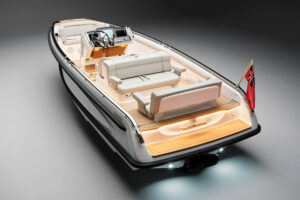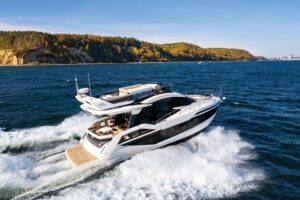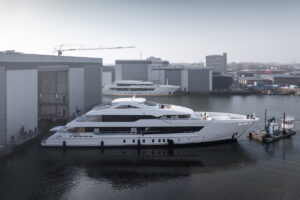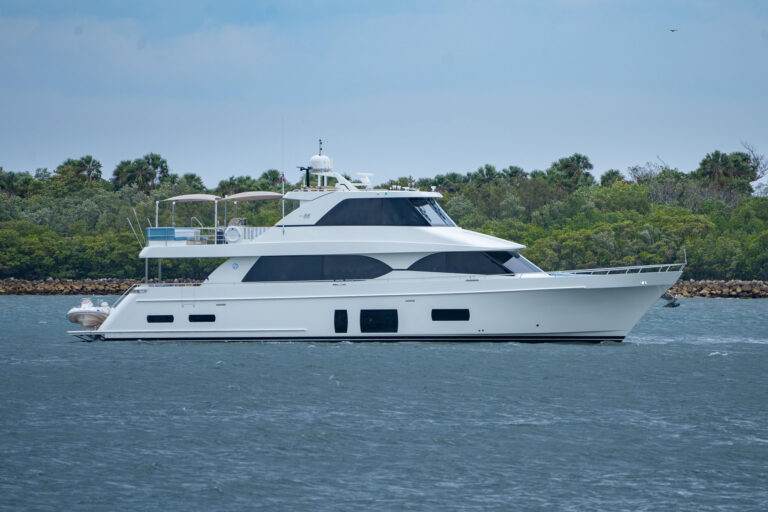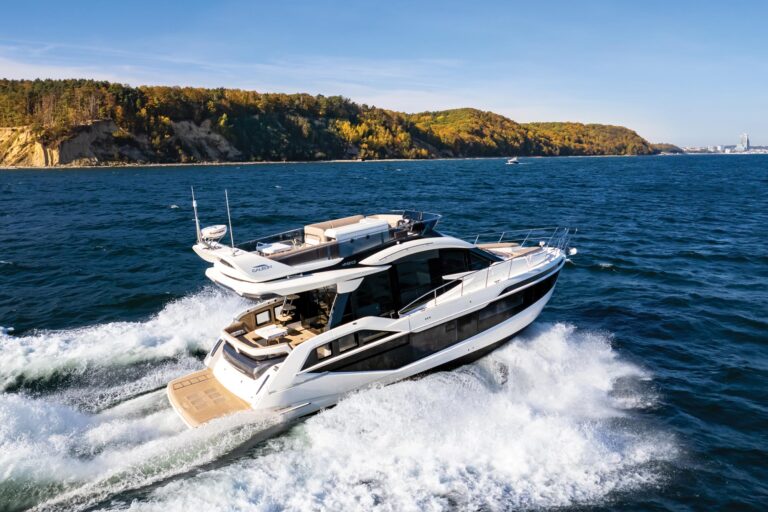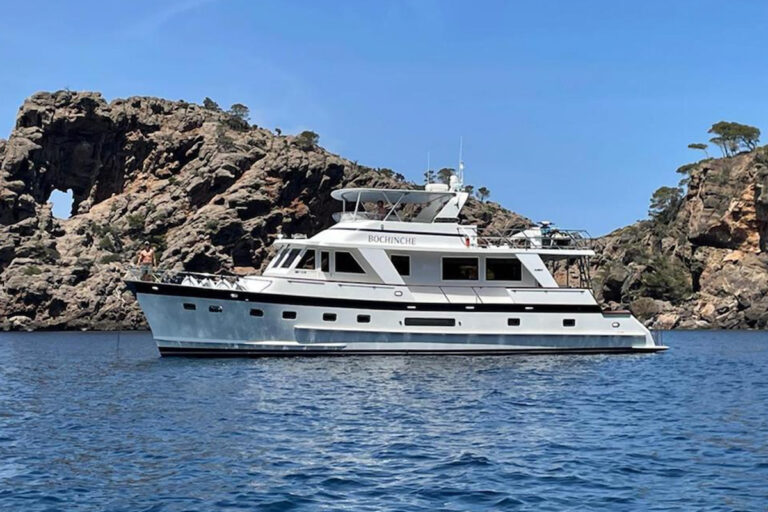Even the most cursory glance at Uniesse’s new 72 Motor Yacht establishes the Italian builder’s passion for wood. Wood, immersed in syrupy layers of gloss, is literally everywhere inside this beauty. From the teak-plank deck to the interior’s total absence of fiberglass, the 72 is a yacht from a builder that appreciates fine hardwood.
This woodworking finesse is not surprising, because the builder has worked with wood-albeit in somewhat smaller pieces-since World War II. Uniesse Marine is a division of Gruppo Uniesse, which is arguably Europe’s leading manufacturer of buttons. In the early part of the 20th century, buttons were wood, so Uniesse gained a wealth of experience in selecting and finishing exotic types. When plastic buttons became popular, after the war, Uniesse quickly mastered that medium. Since boats were a passion for the founding Scaburri brothers, it wasn’t long before their experience in wood and plastic led to yachts.
The 72 is the largest yacht in the Uniesse fleet (and will remain so until next year, when an 80-footer will launch). Though there was an earlier 70-foot model, the 72 is a new design from keel to flying bridge. An experienced owner-perhaps one who plans to run the 72 himself-will likely appreciate her most. The company’s continuing reverence for wood is reflected in its building process. The furniture is mostly solid, and the teak decks are individually hand-planked.
With striking dark-blue topsides, created with an extra-thick coating of high-temperature gelcoat to resist chalking even in the tropics, the Uniesse 72 is every inch an Italian stallion. The steeply raked pilothouse windows, oval hull portholes, and reverse transom are contemporary, but the soft curve of the sheer up to the bow has a timeless beauty.
The starting point for the 72 is a seaworthy hull from the boards of Fred Hudson, a long-time partner of performance designer Jim Wynne. The variable deadrise hull ranges from a wave-slicing 56 degrees forward to a stable, economical 14 degrees aft. As I discovered offshore, this is a dry and smooth-running hull even in sloppy conditions.
One of the delights of a yacht like the Uniesse 72 is discovering small details that make a big difference, and one is in the cockpit. Docklines on the 72 are tucked out of sight. A hinged panel on each after coaming conceals not only the cleats and Lofrans warping windlasses, but a large bin to handle the extra line. Even better, the bins are actually sinks; each has a freshwater faucet for rinsing lines (and hands).
Moving forward on the main deck is safe and secure, in part because of waist-high bulwarks, in part because the stainless-steel rails flare outward, but mostly because the designer provided extra foot room by creating a notched toe kick around the cabin at deck level.
Another thoughtful touch is the placement of the oversize air-intake baffles on the cabin side below bulwark level. Not only does this keep from marring the hull lines with industrial gratings, it prevents salt spray from infiltrating the engineroom.
The saloon layout is conventional, with a wraparound settee and pop-up TV in a setting of high-gloss cherry. The windows have electrically operated Roman shades, and clever sliding shade panels quickly close off the afterdeck.
Up two steps from the saloon are the formal dining area, galley and pilothouse. In the European style, the galley is fully enclosed, but Jerry Berton of Global Yachts, Uniesse’s U.S. importer, said it can easily be opened fore and aft. While the cabinets on this particular yacht are finished in white lacquer, the Uniesse appreciation of fine materials is reflected in the book-matched black-and-gold Botticino marble sole and counters.
Tucked to starboard of the galley is the cherry dining table, which easily seats six. A settee is available on the outboard side to save space, but it would be a shame to give up any of the stunning Cassina dining chairs, in buttery leather.
The lower helm is a working area with a single seat, and though an L-shape, aft-facing settee allows guests to keep the skipper company, their only view while seated is aft. An electric Opacmare helm seat on a raised platform faces the burled-wood-and-leather-trimmed instrument panel. The engine and thruster controls are on the outboard side of the seat, which requires the skipper to be seated when using them. I’ve never cared for left-handed controls, and I’d prefer to be able to use the them while standing next to the seat and facing aft. This helm, however, will more likely be used for cruising than for maneuvering.
This is a big 72-footer, boasting four real staterooms, including a full-beam master, and a two-berth crew cabin aft. Gentle stairs lead from the pilothouse to a fore-and-aft passageway with the master at the after end and the VIP stateroom forward. The master layout is traditional, with two large hanging lockers on each side of the king berth, a loveseat and vanity to port and starboard, and an en suite head with bidet forward.
Forward staterooms traditionally have smaller berths to fit the narrowing bow, but this one features a king berth and similar décor to the master with Roman shades over opening portholes, a creamy inlaid marble sole in the head, and twin hanging lockers. The two mid-cabins are surprisingly spacious, with twin berths and private heads with showers.
Given decent weather, the flying bridge likely will be a popular gathering spot. With that in mind, Uniesse has fitted it with creature comforts: a big settee and table, an even bigger sunpad, and a mini-galley, which includes a two-burner cooktop and grill, fridge/icemaker and sink. The electronic goodies are protected in a pop-up console behind the wraparound windscreen, while switches are under waterproof touchpad membranes. The windscreen is raked enough to show off some imperfection in the glass, which might prove irritating, but it certainly kept the wind off the skipper and crew. The boat deck is large enough to handle a 12-foot Caribe RIB.
Access to the engineroom is through the large crew quarters, with a desk, mini-galley and private head with shower. A systems flat separates the engineroom and contains a washer/dryer, a Marine Air chilled-water package and twin 20kW Kohler gensets.
Our test boat had the standard 1,300 hp MAN diesels; engines up 1,500 hp are optional. Access is a bit tight outboard between the fuel tanks and engines, but it’s clear redundancy has been built into the Uniesse-many systems, all of which are linked to a master alarm panel at each helm, have backup capability.
Under way, the 72 was surprisingly quick for a 118,026-pound yacht, which suggests the hull is quite slippery. Though there were teething problems with new propellers, we still reached a top speed of just over 30 knots. Plus, unlike most boat tests, our 72 was fully loaded. With a bit of tinkering, Berton expects the 72 to have a half-load top speed of about 34 knots.
Even better than her top speed was the 72’s solid handling. Quartering into the lumpy Gulf Stream seas couldn’t upset this yacht, and the 14-inch keel clearly helped her track straight. Docking is easy with 22 hp thrusters at bow and stern, the 72 spun easily and slid sideways into a pier like filings to a magnet.
Cute as a button would be an obvious cliché to describe this well built and thoughtfully outfitted magnificent yacht, but it’s clear these Italian button makers have done themselves proud.
Contact: Global Yachts International Inc., (305) 371-2628; www.globalyachts.com. For more information, contact: (866) 922-4877

